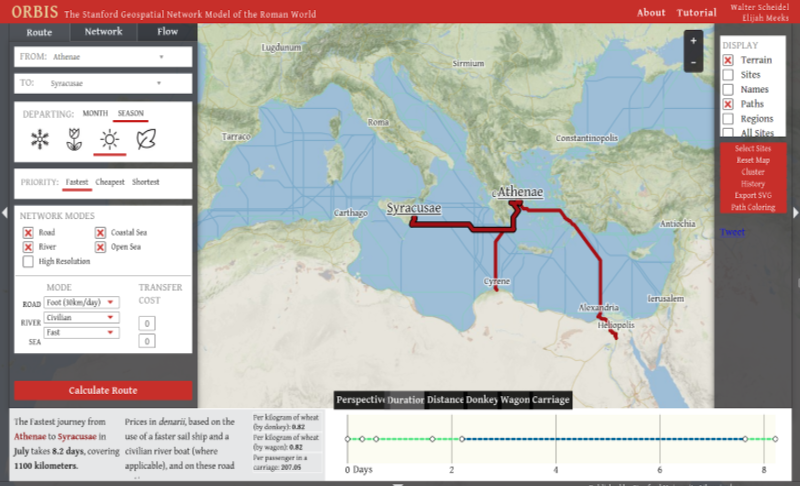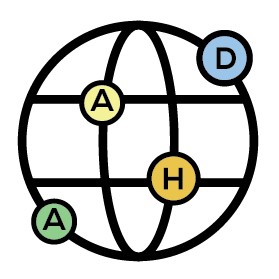Digital Tools in High School: Classroom Experiences from Digital Humanities
DOI:
https://doi.org/10.24215/27187470e058Keywords:
Digital Humanities, Voyant Tools, Orbis, H5P, Moodle, teaching/learning, high schoolAbstract
This paper presents a brief collection of experiences developed with digital tools in the context of Digital Humanities within High School’s Philosophy and History of Philosophy courses. The aim is to demonstrate that at this educational level, it is possible to successfully engage in distant reading, create interactive maps and timelines, among other activities, thereby fostering early awareness of what new technologies are contributing to the Humanities in terms of tools and methodologies. The paper also advocates for the search within the educational system for spaces dedicated to Digital Humanities as a meeting point between the humanities and technology, spaces that help to dismantle the barrier that separates the sciences and the arts—a barrier that only exists in the minds of a portion of society, though it is likely a majority.
Downloads
References
Anderson, L., Krathwohl, D., Airasian, P., Cruikshank, K., Mayer, R., Pintrich, P., Raths, J. y Wittrock, M. (2001). Taxonomy for Learning, Teaching, and Assessing, A: A Revision of Bloom’s taxonomy of educational objectives. Longman.
Arroyo Sagasta, A. (2017). Docentes y escuelas que aprenden en la red. Estudio sobre la competencia digital, entornos personales de aprendizaje y entorno organizacional de aprendizaje de Arizmendi Ikastola [Tesis Doctoral, Universidad Nacional de Educación a Distancia]. https://portalcientifico.uned.es/documentos/5f63fc8e29995274fc8e8f4f
Azcárate, P. de. (2021). Obras Completas de Platón. Filosofía en español. https://www.filosofia.org/cla/pla/azcarate.htm
Bloom, B. S. (1956). Taxonomy of educational objectives: The classification of educational goals. McKay.
Bloom’s taxonomy revised. (s. f.). https://thesecondprinciple.com. Recuperado el 15 de agosto de 2024 de https://thesecondprinciple.com/essential-teaching-skills/blooms-taxonomy-revised/
Castañeda, L., Esteve, F. y Adell, J. (2018). ¿Por qué es necesario repensar la competencia docente para el mundo digital? Revista de Educación a Distancia (RED), 56, 6. http://dx.doi.org/10.6018/red/56/6
Consejo de la Unión Europea. (2006). Recomendación del Parlamento Europeo y del Consejo de 18 de diciembre de 2006 sobre las competencias clave para el aprendizaje permanente (2006/962/CE). Diario Oficial de la Unión Europea. https://eur-lex.europa.eu/LexUriServ/LexUriServ.do?uri=CELEX%3A32006H0962%3AES%3AHTML
Consejo de la Unión Europea. (2018). Recomendación del Consejo, de 22 de mayo de 2018, relativa a las competencias clave para el aprendizaje permanente. Diario Oficial de la Unión Europea. https://eur-lex.europa.eu/legal-content/ES/TXT/?uri=OJ:C:2018:189:TOC
Cordell, R. C. (s. f.). How not to teach Digital Humanities. Recuperado el 15 de agosto de 2024 de https://ryancordell.org/teaching/how-not-to-teach-digital-humanities/
Croxall, B. y Jakacki, D. K. (Eds.). (2023). What we teach when we teach DH: Digital Humanities in the classroom. University of Minnesota Press.
Desmurget, M. (2020). La fábrica de cretinos digitales: los peligros de las pantallas para nuestros hijos (L. C. Fernández, Trad.). Ediciones Península.
Desmurget, M. (2024). Más libros y menos pantallas: cómo acabar con los cretinos digitales (L. C. Fernández, Trad.). Ediciones Península.
Divenosa, M. G. y Mársico, C. T. (2005). La república. Platón. Editorial Losada.
Fernández, P. S. L. (2021). MORETTI, Franco. Lectura distante. Trad. Lilia Mosconi. Fondo de Cultura Económica, Buenos Aires, 2015. Revista de Humanidades Digitales, 6, 266-271. https://doi.org/10.5944/rhd.vol.6.2021.27380
Gold, M. K. y Klein, L. F. (Eds.). (2016). Debates in the Digital Humanities 2016. University of Minnesota Press. https://doi.org/10.5749/j.ctt1cn6thb
Instituto Nacional de Tecnologías Educativas y de Formación del Profesorado. (2022). Competencia digital del alumnado. INTEF. https://intef.es/competencia-digital-educativa/competencia-digital-del-alumnado/
Koehler, M. J., Mishra, P. y Cain, W. (2015). ¿Qué son los Saberes Tecnológicos y Pedagógicos del Contenido (TPACK)? Virtualidad, Educación y Ciencia, 6(10), 9-23. https://doi.org/10.60020/1853-6530.v6.n10.11552
López García, J.C. (2023). La taxonomía de Bloom y sus actualizaciones. Eduteka. https://eduteka.icesi.edu.co/articulos/TaxonomiaBloomCuadro
Moretti, F. (2015). Lectura distante. Fondo de Cultura Económica.
Nivelle, P. (2011). Petite Poucette, la génération mutante. Libération. Recuperado el 15 de agosto de 2024 de https://www.liberation.fr/debats/2011/09/03/petite-poucette-la-generation-mutante_758710/
Portal del Sistema Educativo Español. (2022). Competencia digital. Educagob. https://educagob.educacionfpydeportes.gob.es/curriculo/curriculo-lomloe/menu-curriculos-basicos/bachillerato/competencias-clave/digital.html
Redecker, C. y Punie, Y. (2017). European framework for the digital competence of educators: DigCompEdu (Scientific analysis or review, Policy assessment, technical guidance KJ-NA-28775-EN-C (print),KJ-NA-28775-EN-N (online)). Publications Office of the European Union. https://doi.org/10.2760/178382
Shulman, L. (2013). Those who understand: Knowledge growth in teaching. Journal of Education, 193, 1-11. https://doi.org/10.1177/002205741319300302
Toffler, A. (1993). La tercera ola. Plaza y Janés.
Ursua Lezaun, N. (2016). El pensar humanístico frente a las “humanidades digitales”. Límite: Revista de Filosofía y Psicología, 11(36), 32-40.
Vuorikari, R., Kluzer, S. y Punie, Y. (2022). DigComp 2.2: The Digital Competence Framework for Citizens—With new examples of knowledge, skills and attitudes (Scientific analysis or review KJ-NA-31006-EN-N (online),KJ-NA-31006-EN-C (print)). Publications Office of the European Union. https://doi.org/10.2760/115376

Downloads
Published
How to Cite
Issue
Section
License
Copyright (c) 2024 Juan Eceiza Gutiérrez

This work is licensed under a Creative Commons Attribution-ShareAlike 4.0 International License.
Los autores que publican en esta revista están de acuerdo con los siguientes términos:
- Los artículos publicados en la revista se encuentran disponibles en acceso abierto.
- Los autores conservan los derechos de autor y garantizan a la revista el derecho de ser la primera publicación del trabajo al igual que licenciarlo bajo una Licencia Creative Commons Atribución-CompartirIgual 4.0 Internacional (CC BY-SA 4.0), que permite copiar y redistribuir el material en cualquier medio o formato y remezclar, transformar y construir a partir del material bajo los siguientes términos: debe dar crédito de manera adecuada, brindar un enlace a la licencia, e indicar si se han realizado cambios.
- Los autores pueden depositar el trabajo en un repositorio de preprints, postprints, establecer por separado acuerdos adicionales para la distribución no exclusiva de la versión de la obra publicada en la revista (por ejemplo, situarlo en un repositorio institucional o publicarlo en un libro), con un reconocimiento de su publicación inicial en esta revista.
- Se alienta a los/as autores/as a realizar el depósito de datos en SEDICI, o en cualquier otro repositorio de datos de investigación (como Zenodo, donde la AAHD ha creado un repositorio temático para HUMANIDADES DIGITALES), de manera previa a realizar el envío de la contribución a la revista. De este modo, al remitir el artículo solo se deberá indicar la URL donde se encuentran los datos de investigación.

























